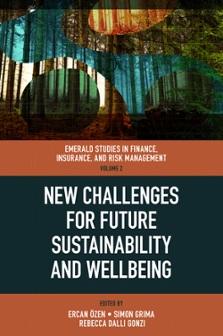
Index
New Challenges for Future Sustainability and Wellbeing
ISBN: 978-1-80043-969-6, eISBN: 978-1-80043-968-9
Publication date: 21 May 2021
Citation
(2021), "Index", Özen, E., Grima, S. and Gonzi, R.D. (Ed.) New Challenges for Future Sustainability and Wellbeing (Emerald Studies in Finance, Insurance, and Risk Management), Emerald Publishing Limited, Leeds, pp. 483-494. https://doi.org/10.1108/978-1-80043-968-920211026
Publisher
:Emerald Publishing Limited
Copyright © 2021 Emerald Publishing Limited
INDEX
- Prelims
- Chapter 1: Financial Inclusion: A Strong Critique
- Chapter 2: The Performance of Pension Funds and Their Impact on Economic Growth in OECD Countries
- Chapter 3: Effects of Reciprocity on Knowledge Sharing Behavior: The Mediating Role of Organizational Commitment
- Chapter 4: Accounting and Financial Reporting During a Pandemic
- Chapter 5: Investigation of Intercultural Sensitivity Levels of Department Managers Working in Hotel Enterprises According to Some Demographic Features
- Chapter 6: Relations Between the Great War and Wheat Prices: An Analysis from the Ottoman Empire Perspective
- Chapter 7: The Effect of Traditional Performance Evaluation Criteria on the Market Value Added: Application on Informatics Index (XBLSM)
- Chapter 8: Social Capital Facing Economic Competition: The Case of Antakya Long Bazaar
- Chapter 9: An Index Proposal for Supply Security Risk in Fossil Energy Imports: The Case of Turkey
- Chapter 10: An Alternative to Corporate Social Responsibility Studies: Intellectual Company
- Chapter 11: The Interaction Between Perceived Risk, Attitude, and Intention to Use: An Empirical Study on Bitcoin as a Crypto Currency
- Chapter 12: Instagram Teachings and Relative Poverty
- Chapter 13: Managing Climate Change Risk: A Responsibility for Politicians Not Central Banks
- Chapter 14: Determinants of Nonperforming Loans: A Review of Empirical Evidence
- Chapter 15: Managing Climate Change Risk: The Policy Options for Central Banks
- Chapter 16: Symmetric and Asymmetric Influence of Macroeconomic Variables on Stock Prices Movement: Study of Indian Stock Market
- Chapter 17: Do Investment Funds Care About the Environment? Evidence from Faith-based Funds
- Chapter 18: Exploring the Internet of Things Within the New Generation Smart Home Systems: A Qualitative Study
- Chapter 19: Financial Inclusion in Nigeria: Determinants, Challenges, and Achievements
- Chapter 20: Evaluation of Factors Affecting the Financial Performance of Borsa İstanbul Cement Sector Companies
- Chapter 21: Measuring Financial Inclusion and Financial Exclusion
- Chapter 22: Competition Regulation in Kosovo: An Emphasis on Enterprises Concentration
- Chapter 23: Internal Branding and Brand Citizenship Behavior: The Role of Trust, Commitment, and Organizational Climate
- Chapter 24: Integrated Reporting and Combined Assurance: A Qualitative Research on the Awareness in Turkey
- Index